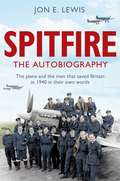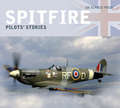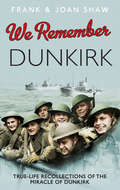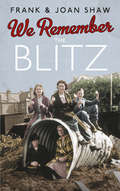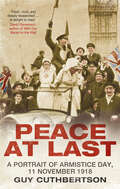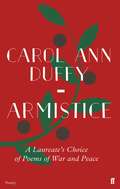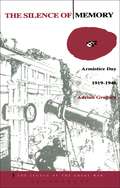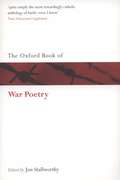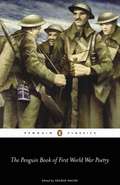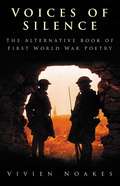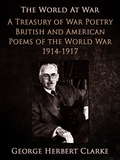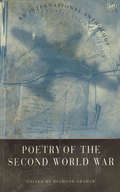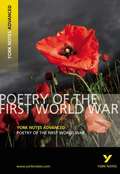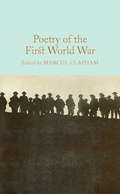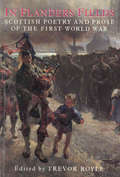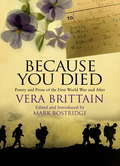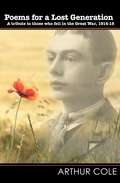Special Collections
Remembrance Day
Description: Book and accessible image resources to commemorate those who died in wars and conflicts
- Table View
- List View
Poppy (UEB uncontracted)
by RnibThere is flower on the left and a flower bud on the right of the page. There is a locator dot shown, which will be at the top left of the page when the image is the correct way up. The image is surrounded by a dashed image border. The poppy flower head is in the top left of the page. It has two outer overlapping petals and two inner overlapping petals. In the middle of the flower head are stamens radiating out from the centre. The inner petal on the right has a black patch at its base. The other three petals will have a similar patch but they are not shown. The flower stem goes down the page to the bottom of the image. In the bottom centre of the page is a single leaf mainly to the right of the stem. The base of the leaf at the bottom is in front of the stem so a short section of stem is hidden. A second stem comes from the bottom right of the page and goes up to the right centre of the page. The stem curls left and down at the top, ending in a rounded hairy flower bud.
Poppy (large print)
by RnibThere is flower on the left and a flower bud on the right of the page. There is a locator dot shown, which will be at the top left of the page when the image is the correct way up. The image is surrounded by a dashed image border. The poppy flower head is in the top left of the page. It has two outer overlapping petals and two inner overlapping petals. In the middle of the flower head are stamens radiating out from the centre. The inner petal on the right has a black patch at its base. The other three petals will have a similar patch but they are not shown. The flower stem goes down the page to the bottom of the image. In the bottom centre of the page is a single leaf mainly to the right of the stem. The base of the leaf at the bottom is in front of the stem so a short section of stem is hidden. A second stem comes from the bottom right of the page and goes up to the right centre of the page. The stem curls left and down at the top, ending in a rounded hairy flower bud.
Poppy (UEB contracted)
by RnibThere is flower on the left and a flower bud on the right of the page. There is a locator dot shown, which will be at the top left of the page when the image is the correct way up. The image is surrounded by a dashed image border. The poppy flower head is in the top left of the page. It has two outer overlapping petals and two inner overlapping petals. In the middle of the flower head are stamens radiating out from the centre. The inner petal on the right has a black patch at its base. The other three petals will have a similar patch but they are not shown. The flower stem goes down the page to the bottom of the image. In the bottom centre of the page is a single leaf mainly to the right of the stem. The base of the leaf at the bottom is in front of the stem so a short section of stem is hidden. A second stem comes from the bottom right of the page and goes up to the right centre of the page. The stem curls left and down at the top, ending in a rounded hairy flower bud.
Spitfire
by Tony HolmesThe Spitfire is an icon of World War II, becoming the darling of the British public through defending the skies during the Battle of Britain. The Spitfire's combat ability and superb handling meant it was loved by British, Commonwealth and American pilots alike, leading to a level of global public recognition which is unparalleled amongst other aircraft – everyone recognises and connects with the iconic Spitfire. Spitfire is a complete reference guide to the world's most famous fighter aircraft, exploring its history, its strengths and weaknesses and its combat performance, using exciting full colour artwork and detailed illustrations throughout to create a premium, high quality product, combined with an affordable low price point.
Spitfire
by Jon E. LewisA celebration of the machine and the men who took to the skies in defence of Britain. It is also the dramatic illustration of a little understood truth: the Spitfire did more than win the Battle of Britain - it won the war. It was not Stalingrad which turned the corner of the war against Hitler, it was the Spitfire in the summer of 1940 when RAF Fighter Command destroyed the myth of Nazi invincibility.Praise for his previous books:London: The Autobiography:'Fascinating ... brings the story of London to life' Good Book guideThe English Soldier: The Autobiography: 'A triumph' Saul David, author of Victoria's Army'Harrowing, funny and often unbelievable book.' Daily Express'[A] compelling tommy's eye view of war from Agincourt to Iraq' Daily Telegraph
Supermarine Spitfire (UEB uncontracted)
by RnibThis page shows two images of an aircraft. At the top of the page seen from the side and in the bottom and middle of the page a plan view seen from above. There is a locator dot shown, which will be at the top left of the page when the image is the correct way up. Both views have the front on the left and the tail on the right of the page. The aircraft is shown in a flying position so the wheels are retracted and not shown. The aircraft in the top of the page has the propeller on the left with one blade pointing up and one pointing down. The nose cone is pale grey. Right from this is a rectangle which comprises six exhaust outlets. Down and right from the exhaust is the tip of the wing pointing towards you. The front edge on the left has a cannon sticking out. Up from the wing in the middle top of the fuselage is the cockpit cover shown as two windows. The centre of the fuselage has letters identifying which individual aircraft it is. There is also red and blue roundel indicating the plane belongs to the RAF. On the top edge of the fuselage there is an aerial sticking up. Right of this the fuselage continues to the vertical tail fin on the right. At base of the fin is the end of one of the tail wings. Right of this is a vertical flap. This is one of the ailerons used to manoeuvre the aircraft when it is flying. The tail has a red rectangle and a blue rectangle separated by a white line indicating the plane belongs to the RAF. In the plan view image in the bottom and middle of the page the fuselage goes from left to right in the centre of the image. The main wings go up and down the page from the fuselage. In the left of the page the propeller has one blade pointing up and one pointing down. The tip of the nose cone is pale grey. To the right of the propeller six exhaust outlets can be found on the top and bottom edge of the fuselage. Right of this are the wings. Each wing has two cannons mounted on the front edge. In the centre of each wing there is a red and blue roundel indicating the plane belongs to the RAF. On the right of each wing tip is a flap. These are two of the ailerons used to manoeuvre the aircraft when it is flying. In the centre of the fuselage between the wings is the cockpit shown as two windows. The fuselage continues to the right ending in the tailplane. On the right of each tail wing is a flap. These are two more of the ailerons used to manoeuvre the aircraft when it is flying.
Spitfire
by Dr Alfred PriceThe narrative description and condensed history of the Spitfire’s construction, combat career and post-war service, bought together to tell the complete, concise history of the world’s most famous aircraft of all time and undoubtedly the finest fighter of World War 2. When Spitfire at War first appeared in 1974, it enjoyed critical acclaim, for the aircraft had never been described in such terms and detail before. It was followed by a second volume in 1985 and a third volume in 1990. All three volumes sold well and are hailed as classic works on the subject. These important works have been out of print for more than a decade, thereby denying them to the current breed of aviation buffs. The time has come to re-issue the three books as a single volume, the author ‘cherry-picking’ the choice cuts to produce the finest title on the mighty and beloved Spitfire.
Supermarine Spitfire (UEB contracted)
by RnibThis page shows two images of an aircraft. At the top of the page seen from the side and in the bottom and middle of the page a plan view seen from above. There is a locator dot shown, which will be at the top left of the page when the image is the correct way up. Both views have the front on the left and the tail on the right of the page. The aircraft is shown in a flying position so the wheels are retracted and not shown. The aircraft in the top of the page has the propeller on the left with one blade pointing up and one pointing down. The nose cone is pale grey. Right from this is a rectangle which comprises six exhaust outlets. Down and right from the exhaust is the tip of the wing pointing towards you. The front edge on the left has a cannon sticking out. Up from the wing in the middle top of the fuselage is the cockpit cover shown as two windows. The centre of the fuselage has letters identifying which individual aircraft it is. There is also red and blue roundel indicating the plane belongs to the RAF. On the top edge of the fuselage there is an aerial sticking up. Right of this the fuselage continues to the vertical tail fin on the right. At base of the fin is the end of one of the tail wings. Right of this is a vertical flap. This is one of the ailerons used to manoeuvre the aircraft when it is flying. The tail has a red rectangle and a blue rectangle separated by a white line indicating the plane belongs to the RAF. In the plan view image in the bottom and middle of the page the fuselage goes from left to right in the centre of the image. The main wings go up and down the page from the fuselage. In the left of the page the propeller has one blade pointing up and one pointing down. The tip of the nose cone is pale grey. To the right of the propeller six exhaust outlets can be found on the top and bottom edge of the fuselage. Right of this are the wings. Each wing has two cannons mounted on the front edge. In the centre of each wing there is a red and blue roundel indicating the plane belongs to the RAF. On the right of each wing tip is a flap. These are two of the ailerons used to manoeuvre the aircraft when it is flying. In the centre of the fuselage between the wings is the cockpit shown as two windows. The fuselage continues to the right ending in the tailplane. On the right of each tail wing is a flap. These are two more of the ailerons used to manoeuvre the aircraft when it is flying.
Supermarine Spitfire (large print)
by RnibThis page shows two images of an aircraft. At the top of the page seen from the side and in the bottom and middle of the page a plan view seen from above. There is a locator dot shown, which will be at the top left of the page when the image is the correct way up. Both views have the front on the left and the tail on the right of the page. The aircraft is shown in a flying position so the wheels are retracted and not shown. The aircraft in the top of the page has the propeller on the left with one blade pointing up and one pointing down. The nose cone is pale grey. Right from this is a rectangle which comprises six exhaust outlets. Down and right from the exhaust is the tip of the wing pointing towards you. The front edge on the left has a cannon sticking out. Up from the wing in the middle top of the fuselage is the cockpit cover shown as two windows. The centre of the fuselage has letters identifying which individual aircraft it is. There is also red and blue roundel indicating the plane belongs to the RAF. On the top edge of the fuselage there is an aerial sticking up. Right of this the fuselage continues to the vertical tail fin on the right. At base of the fin is the end of one of the tail wings. Right of this is a vertical flap. This is one of the ailerons used to manoeuvre the aircraft when it is flying. The tail has a red rectangle and a blue rectangle separated by a white line indicating the plane belongs to the RAF. In the plan view image in the bottom and middle of the page the fuselage goes from left to right in the centre of the image. The main wings go up and down the page from the fuselage. In the left of the page the propeller has one blade pointing up and one pointing down. The tip of the nose cone is pale grey. To the right of the propeller six exhaust outlets can be found on the top and bottom edge of the fuselage. Right of this are the wings. Each wing has two cannons mounted on the front edge. In the centre of each wing there is a red and blue roundel indicating the plane belongs to the RAF. On the right of each wing tip is a flap. These are two of the ailerons used to manoeuvre the aircraft when it is flying. In the centre of the fuselage between the wings is the cockpit shown as two windows. The fuselage continues to the right ending in the tailplane. On the right of each tail wing is a flap. These are two more of the ailerons used to manoeuvre the aircraft when it is flying.
We Remember Dunkirk
by Frank Shaw and Joan Shaw‘Yes we were scared. It could be seen on the faces of the men. No food didn’t help. We stopped to suck pebbles during the day as our tongues began to swell through lack of water … We had an order come through to us one day. Every man for himself. And then the soldiers – Belgian, French and British – were side by side in silent soddy ranks in columns, zig-zagged across the beaches. I still believe this was done to minimise casualties. We had to wade out up to our necks in water to get onto a boat, ducking under the water when the Germans tried to mow us down. Eventually I managed to grab a chain hanging off a Naval motorboat, and it was fully loaded but I hung on …’ Arthur Thomas Gunn, Walsall Between 27 May and 4 June 1940 over 900 vessels rescued 338,226 people trapped at Dunkirk. Cut off by the advancing German Army hundreds of thousands of Allied troops gathered on the beaches – exhausted, hungry and scarred by war. Operation Dynamo saw British destroyers and the hundreds of ‘little ships’ bring these men safely back to England, where they were welcomed back by the locals with tea and sandwiches, and hailed as heroes. In We Remember Dunkirk we hear stories from the soldiers who made the perilous journey to Dunkirk and came under constant attack from Nazi aircraft as they boarded British ships and attempted to cross the Channel. But we also hear from the nurses who tended the many returning wounded; the young women who, along with the rest of their communities, rallied to make food and gather whatever they could to give the soldiers; and what it was like witnessing all this through a child’s eyes. Above all, we see how the solidarity of the British people gave rise to the unfailing ‘Dunkirk Spirit’.
We Remember the Blitz
by Frank Shaw and Joan Shaw'I went to the public baths and after I undressed I could hear someone whistling. I looked round to see if I could see anybody about, but I couldn't, so I got into the bath and lay back to relax. As soon as I did, of course, I looked up and saw a man putting in the glass windows that had been blown out the night before.' Joan Adams, LichfieldOn the night of 7 September 1940, bombs rained down on the defenceless and unprepared population of London for nine long hours. In November, raids spread to the rest of the country - starting in Coventry and taking in everywhere from Portsmouth, Cardiff, Belfast and Hull. During the nine months of the Blitz, thousands of people were killed and injured, and thousands of buildings and homes destroyed. But, with stoicism and humour, life went on.We Remember the Blitz is packed with vivid recollections from this important time in British history. Waking up in a damp shelter to the sound of bombing. Coming out of a cinema to discover that fires made night as bright as day. And, worst of all, the shock of seeing individuals and whole families killed in an instant. We hear from many who were there to pick up the pieces: ARP wardens, firemen - even the bakers, who would return to work under tarpaulin to ensure their neighbours had their daily loaf. Filled with moving but often funny memories, We Remember the Blitz is a celebration of the British spirit, and clearly shows that the battle for Britain was won by 'the many'.
Peace at Last
by Guy CuthbertsonA vivid, original, and intimate hour-by-hour account of Armistice Day 1918, to mark its centenary this year November 11, 2018, marks the centenary of the armistice signed between the Allies and Germany ending World War I. While the events of the war and its legacy are much discussed, this is the first book to focus solely on the day itself, examining how the people of Britain, and the wider world, reacted to the news of peace. In this rich portrait of Armistice Day, which ranges from midnight to midnight, Guy Cuthbertson brings together news reports, literature, memoirs, and letters to show how the people on the street, as well as soldiers and prominent figures like D. H. Lawrence and Lloyd George, experienced a strange, singular day of great joy, relief, and optimism.
Armistice
by Carol Ann DuffyThe Armistice of 1918 brought ceasefire to the war on the Western Front, but 'the Great War' would not as hoped be 'the war to end all wars'. In this affecting selection, the Poet Laureate, Carol Ann Duffy, guides us deep into the act and root of 'armistice': its stoppage or 'stand' of arms, its search for truce and ceasefire. In 100 poems, our most cherished poets of the Great War speak alongside those from other conflicts and cultures, so that we hear some of the lesser-heard voices of war, including wives, families, those left behind. These poems of war and peace memorialise the horror and the tragedy of conflict. At the same time, in armistice, they become a record of renewal and a testimony to hope.
The Silence of Memory
by Adrian GregoryThis book examines how the British people came to terms with the massive trauma of the First World War. Although the literary memory of the war has often been discussed, little has been written on the public ceremonies on and around 11 November which dominated the public memory of the war in the inter-war years. This book aims to remedy the deficiency by showing the pre-eminence of Armistice Day, both in reflecting what people felt about the war and in shaping their memories of it. It shows that this memory was complex rather than simple and that it was continually contested. Finally it seeks to examine the impact of the Second World War on the memory of the First and to show how difficult it is to recapture the idealistic assumptions of a world that believed it had experienced 'the war to end all wars'.
The Oxford Book of War Poetry
by Jon StallworthyThere can be no area of human experience that has generated a wider range of powerful feelings than war. The 250 poems in Jon Stallworthy's classic and celebrated anthology span centuries of human experience of war, from David's Lament for Saul and Jonathan, and Homer's Iliad, to the finest poems of the First and Second World Wars, and beyond. Reflecting the feelings of poets as diverse as Byron, Hardy, Owen, Sassoon, and Heaney, they chart a great shift in human awareness - from man's early celebratory war-songs' to the twentieth century's darker poetic responses to man's inhumanity to man'.
The Penguin Book of First World War Poetry
by Matthew George WalterThis anthology reflects the diversity of voices it contains: the poems are arranged thematically and the themes reflect the different experiences of war not just for the soldiers but for those left behind. This is what makes this volume more accessible and satisfying than others. In addition to the established canon there are poems rarely anthologised and a selection of soldiers' songs to reflect the voices of the soldiers themselves.
Voices of Silence
by Vivien NoakesThe poetry of the First World War has determined our perception of the war itself. This volume features poetry drawn from old newspapers and journals, trench and hospital magazines, individual volumes of verse, gift books, postcards, and a manuscript magazine put together by conscientious objectors.
A Treasury of War Poetry British and American Poems of the World War 1914-1917
by George ClarkeThis book contains poetry from numerous countries all centred around the subject of war. Primarily British and American poems dating from 1914 to 1917 have been collected in this edition by the editor George Clarke. The subject matter of these poems encompass patriotism, courage, self-sacrifice, enterprise, and endurance. Authors included are V Lindsay, Galsworthy, Kipling and others. (Excerpt from Goodreads)
Poetry Of The Second World War
by Desmond GrahamPoetry of the Second World War brings to light a neglected chapter in world literature. In its chorus of haunting poetic voices, over a hundred of the most articulate minds of their generation record the true experience of the 1939-45 conflict, and its unending consequences. In keeping with its subject, it has an international scope, with poems from over twenty countries, including Japan, Australia, Europe, America and Russia; poems in which human responses echo each other across boundaries of culture and state. Auden, Brecht, Stevie Smith, Primo Levi, Zbigniew Herbert and Anna Akhmatova are set alongside the eloquence of unknown poets. The anthology has been arranged to bring out the chronological and cumulative human experience of the war: pre-war fears, air raids, the boredom, fear and camaraderie of military life; battle, occupation and resistance; surviving and the aftermath. Here at last, are the poems of the Holocaust, the Blitz, Hiroshima; of soldiers, refugees and disrupted lives. What emerges is a poetry capable of conveying the vast and terrible sweep of war.
Poetry Of The First World War
by York Notes and Tom RankThe 'York Notes' series covers major works from medieval to modern English literature, and classic and contemporary works from Europe, America, the Commonwealth and the Third World.
Poetry of the First World War
by Marcus ClaphamThe First World War was one of the deadliest conflicts in modern history and produced horrors undreamed of by the young men who cheerfully volunteered for a war that was supposed to be over by Christmas. Whether in the patriotic enthusiasm of Rupert Brooke, the disillusionment of Charles Hamilton Sorley, or the bitter denunciations of Siegfried Sassoon and Wilfred Owen, the war produced an astonishing outpouring of powerful poetry. Edited by author and editor Marcus Clapham, the major poets are all represented in this beautiful Macmillan Collector’s Library anthology, Poetry of the First World War, alongside many others whose voices are less well known, and their verse is accompanied by contemporary motifs.Designed to appeal to the booklover, the Macmillan Collector's Library is a series of beautiful gift editions of much loved classic titles. Macmillan Collector's Library are books to love and treasure.
In Flanders Fields
by Trevor RoyleThis anthology is the first ever acknowledgement of Scotland's unique contribution to the literature of the First World War. Here are gathered together well-known writers like John Buchan, Eric Linklater, Hugh MacDiarmid and Compton Mackenzie, as well as poets like Joseph Lee and Roderick Watson Kerr, who found their true voices fighting in a war to end wars. There is also a substantial contribution from women writers in the work of Violet Jacob, Naomi Mitchison and Mary Symon.
Because You Died
by Vera BrittainThis collection of Vera Brittain's poetry and prose, some of it never published before, commemorates the men she loved - fiancé, brother and two close friends - who served and died in the First World War. It draws on her experiences as a VAD nurse in London, Malta, and France, and illustrates her growing conviction of the wickedness of all war.Illustrated with many extraordinary photographs from Brittain's own albums, and edited with a new introduction by Mark Bostridge, Because You Died is an elegy to men who lost their lives in a bloody conflict, and a volume of remembrance to mark the ninetieth anniversary of the Armistice.
Poems for a Lost Generation
by Arthur ColeI was introduced to World War One poetry in the early 60’s by my then English Literature teacher Mr David John, who is sadly now deceased. Mr John was a young teacher at the time, with new ways of getting students to enjoy literature through history, hence the First World War. He introduced us to the war poets like Wilfred Owen, Siegfried Sassoon and Rupert Brooke, amongst others. Mr John made our lessons interesting and many of us questioned the futility of the war, even though we were so young. I left school at sixteen and then began my working career and later married life, so I didn’t do anything with regard to poetry, however I still took an interest in World War One documentaries. It wasn’t until I retired that I toyed with the idea of writing war poetry. I wrote my first war poem at the beginning of 2016, entitled ‘War Horse’ and my writing has just developed from there, resulting in the publication of this book. We must never forget the sacrifices that were made in this war of all wars, on both sides. Many young men thought it was just a game of war, how wrong they were. I hope the book does justice to those who fought and survived and those who sadly never returned to their families, many of whom are buried in far foreign fields. May they all Rest In Peace.


